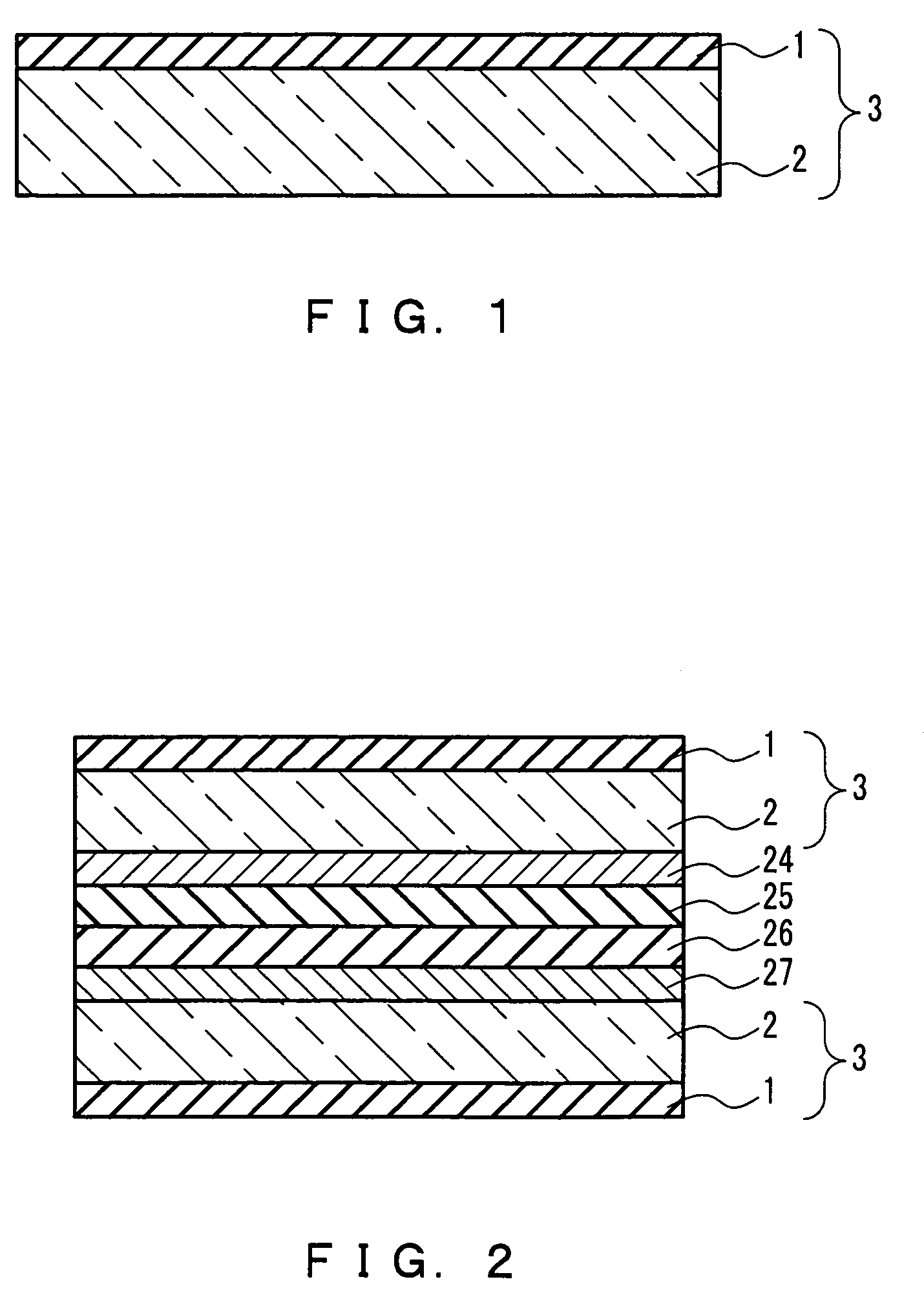Organic luminescence device and its production method
a luminescence device and organic technology, applied in the manufacture of electrode systems, electric discharge tubes/lamps, discharge tubes luminescence screens, etc., can solve the problems of insufficient glass substrate in the luminescence device, very susceptible to the luminescence device, and insufficient gas-barrier capability of the glass substra
- Summary
- Abstract
- Description
- Claims
- Application Information
AI Technical Summary
Benefits of technology
Problems solved by technology
Method used
Image
Examples
embodiment 1
[0018]FIG. 1 is a cross-sectional view showing a substrate with a gas-barrier film of the present invention. In FIG. 1, reference numeral 1 denotes a gas-barrier film, 2 denotes a substrate, and 3 denotes a substrate with a gas-barrier film. Furthermore, FIG. 2 is a cross-sectional view showing an organic luminescence device of the present invention. In FIG. 2, reference numeral 24 denotes a negative electrode, 25 an organic luminescence layer, 26 denotes a hole transporting layer, and 27 denotes a positive electrode.
[0019] First, a gas-barrier film 1 (thickness: 150 Å) composed of silicon oxide that is an amorphous oxide, boron oxide, and titanium oxide was formed on one surface of the substrate 2 made of glass, using RF magnetron sputtering, whereby a substrate 3 with a gas-barrier film was produced. The RF magnetron sputtering was performed under the condition that a pellet of boron oxide and titanium oxide was placed on a target made of silicon oxide with the glass substrate 2 ...
embodiment 2
[0023] An organic luminescence device was produced in the same way as in Embodiment 1, except that a phosphorus oxide and a lead oxide were used in place of the boron oxide and the titanium oxide. The oxygen gas permeation amount of the substrate with a gas-barrier film was measured to be 0.01 g / m2 / 24 h or less (measuring limit or less).
[0024] In the gas-barrier film of the present embodiment, the phosphorus oxide and the lead oxide close gaps of the silicon oxide composed of a network structure, so that the permeation of gas is suppressed. Consequently, in the organic luminescence device using the substrate with a gas-barrier film of the present embodiment, oxygen, water vapor, etc. did not enter the device from outside, so that luminescence failures did not occur.
embodiment 3
[0025] An organic luminescence device was produced in the same way as in Embodiment 1, except that a sodium oxide and a barium oxide were used in place of the boron oxide and the titanium oxide. The oxygen gas permeation amount of the substrate with a gas-barrier film was measured to be 0.01 g / m2 / 24 h or less (measuring limit or less).
[0026] In the gas-barrier film of the present embodiment, the sodium oxide and the barium oxide close gaps of the silicon oxide composed of a network structure, so that the permeation of gas is suppressed. Consequently, in the organic luminescence device using the substrate with a gas-barrier film of the present embodiment, oxygen, water vapor, etc. did not enter the device from outside, so that luminescence failures did not occur.
PUM
| Property | Measurement | Unit |
|---|---|---|
| glass transition temperature | aaaaa | aaaaa |
| atomic radius | aaaaa | aaaaa |
| temperature | aaaaa | aaaaa |
Abstract
Description
Claims
Application Information
 Login to View More
Login to View More - R&D
- Intellectual Property
- Life Sciences
- Materials
- Tech Scout
- Unparalleled Data Quality
- Higher Quality Content
- 60% Fewer Hallucinations
Browse by: Latest US Patents, China's latest patents, Technical Efficacy Thesaurus, Application Domain, Technology Topic, Popular Technical Reports.
© 2025 PatSnap. All rights reserved.Legal|Privacy policy|Modern Slavery Act Transparency Statement|Sitemap|About US| Contact US: help@patsnap.com


